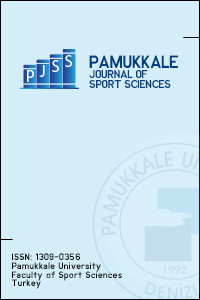Research of the Coordination Abilities in Rhythmic Gymnastics
Research of the Coordination Abilities in Rhythmic Gymnastics
AbstractThe research is aimed at studying some components of coordination abilities – coordination in rhythm and agility among 72 students from Coach Department of the NSA “Vassil Levski” in Sofia. Four tests were used to assess the coordination in rhythm (Frontal feet and hands hitting against a wall, Feet and hands hitting (in a corner), Jumps in four squares, Cross jumps in four squares) and two tests for assessment of agility (Sideward running 10x5 meters, “T” test). The results from the tests – Jumps in four squares and Cross jumps in four squares – correlate to a great extend with the gymnasts (.707**) and moderately with the athletes practicing other kinds of sports. The results from the tests for agility correlate with gymnasts to a great extent (.702**), and moderately with the athletes practicing other kinds of sports 684**). The coefficients of correlation with the tests for agility do not show any dependence on the tests for coordination in rhythm with both groups of subjects.
Keywords:
coordination, rhythmic gymnastics other sports,
___
- 1. Bompa T. (2006). Total training for Young Champions. Human Kinetics, p.43.
- 2. Damjanovska, M., S. Gontarev, L. Radisavljevic (2013).Determination of measurement characteristics for rhythmic skills assessement tests. Conference proceedings, Effects Of Physical Activiti Application to Anthropological Status With Children, Youth and Adults.Univezrzitet u Beogradu, Fakultet sporta I fizickog vaspitanja, 11-12 decembar, Beograd.
- 3. Damjanovska,M., Gontarev, S., Rhedzepi, A., Gantcheva, G.(2015). Comparing reliability and validity of some tests with classic and image model of assessement rhythmic ability.Sborník příspěvků z mezinárodní vědecké conference. Evropské Pedagogické Fórum, 23-27.11. Vol. V. ISBN 978-80-87952-11-5 Hardek Králové, Česká Republika.
- 4. Dimitrova, B. (2015). Coordination abilities and selection in gymnastics. Activities in Physical Education and Sport. Vol. 5, No.2, pp. 214-243.
- 5. Gantcheva, G. (2017). Survey of the difficulty-composition relation with the ensembles in Rhythmic gymnastics, Research in kinesiology, International Journal of Kinesiology and Other Related Sciences, Federation of the Sports Pedagogues of the Republic of Macedonia, Skopje, 7-9.
- 6. Hadjiev, N. at. All (2011). Gymnastics – physical preparation, NSA PRESS, Sofia..рр. 101-115.
- 7. Hafe, R., A. (2016). Impact of coordination abilities program on accuracy and speed in rhythmic gymnastics. Science, Movement and Health, Vol. XVI, ISSUE 16 (2), 141-146.
- 8. Jastrjembskаја N, Titov, Y, (1999). Rhythmic Gymnastics. Human Kinetics, UK.
- 9. Каrpenco, L. А. (2003) Rhythmic Gymnastics. Textbook. Russian Federation of Rhythmic Gymnastics (RFRG), State Academy of Physical Culture, St. Petersburg (SPGAFK) “P. F. Lesgaft”. Moscow .
- 10. Macovei, S. (2006) Balance – technical requirement and specific motor quality – from theory to practice. International Meeting on Rhythmic Gymnastics: identity and sports issues. Torino. Italy.рр. 46-55.
- 11. Miletić, Đ., Jeličić, M. &Oreb, G. (2007). The effects of a visual model and knowledge of performance on dance skills.Kinesiologia, Slovenica, 13 , 1; 31-40.
- 12. Viner-Usmanova, I. (2015), Theory and methods of rhythmic gymnastics – artistry and its development. SPORT, Moscow.
- Başlangıç: 2010
- Yayıncı: Pamukkale Üniversitesi
Sayıdaki Diğer Makaleler
Günay YILDIZER, Deniz ŞİMŞEK, İzzet KIRKAYA, Elvin ONARICI GÜNGÖR
Eda MUŞTU ÖZYAKAN, Leyla SARAÇ
EVALUATION OF GENDER KNOWLEDGE, BEHAVIORS AND ATTITUDES OF PHYSICAL TRAINING AND SPORTS STUDENTS
Nermin GÜRHAN, Azize ATLI ÖZBAŞ, Mehmet KOÇAK
Research of the Coordination Abilities in Rhythmic Gymnastics
Self-Objectification in the Fitness Center Environment: A Qualitative Perspective
Emine KUTLAY, Ercan HASLOFÇA, Tezan BİLDİK, Manuel SİLLERO QUİNTANA
